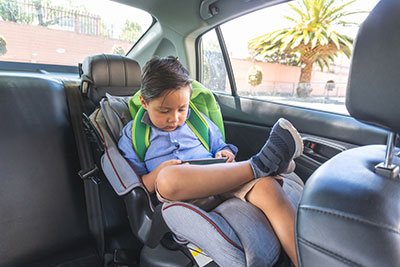Choosing the best car seat for your child can be overwhelming. There are so many types of seats, sizes, and safety measures to think about!
One critical decision you'll need to make when purchasing a booster seat is whether or not you want one with LATCH (Lower Anchors and Tethers for Children) capabilities.
This blog post aims to help parents navigate these options to decide on the best choice of booster seat latch vs no latch for their family—and we've put together an awesome guide for parents.
More...
Take Away Key Points:
Booster seats with or without the LATCH system? All you need to know
Since the child's safety is your top priority on the road, you must ensure the best car seat installation to avoid severe injuries in accidents. For this reason, we will explain whether or not you should use the booster seat with the LATCH system.
1. Do booster seats use seat belts or LATCH?

Booster car seats mostly use a vehicle's seat belt to secure the child in the booster seat. Some booster car seats are also equipped with LATCH connectors, which can be used to attach the booster seat to the vehicle.
However, it is important to note that LATCH is not designed for use with booster seats and should only be used when instructed by the car seat manufacturer.
To further explain the LATCH installations compared to no-LATCH methods, we will refer to the research conducted by safety experts. The research used four high-back booster mode car seat models, and two backless booster models, using the lower anchors and seat belt method. The research also included the belt webbing and retractor for more precise results. We will refer to the results and booster responses of each section below.
2. Can lower anchors and seat belts work together in a safety seat?
LATCH works together with lap and shoulder belts only to increase the child's safety. You cannot utilize the seat belt and LATCH systems together for the safety seat installation. But these two systems work together to keep the little one safe and secure while in the back seat of your vehicle.
The safety seat works the following way: the LATCH connectors and the top tether strap lock the car seat into the correct position in the vehicle seat cushion. In addition, the production vehicle seat buck is attached to the sled. Finally, the lap and shoulder belt lock uses the emergency locking mode to lock the little one in the car seat.
Ideally, if possible, you should always install a top tether strap for any forward-facing car seat and a high-back booster mode. The top tether strap adds extra stability and security to your car seat and prevents it from moving forward in the event of an accident. It also keeps the child's head and neck and reduces the risks of fatalities in a collision. Thus, the top tether strap ensures the proper seating position of the child in the safety seat.
The system affects the overall performance of the booster in the frontal impact. The safety method prevents the ejection of the child and the seat from their designated positions in the vehicle, keeping them secure and fixed on the road.
3. Are booster seats without LATCH safe?
Yes, booster car seats without LATCH are safe. Booster car seats are designed to raise the child off the vehicle seat, leading to a better seat belt fit. This is important for ensuring the seat belt fits properly across the child's body and provides adequate protection in an accident.
The research has shown that using LATCH reduces the forward movement of the booster itself by 32.3% to 71.5% compared to non-LATCH installations. In addition, the shoulder belt loads showed a valuable reduction when the LATCH method used the top tether strap. But, chest resultant accelerations were higher for the LATCH method, while one booster non-LATCH reduced the numbers.
Therefore, while it is recommended that you use a booster seat with LATCH if possible, boosters with non-LATCH systems can still provide adequate safety for your child when used correctly.
Then, is it better to use the LATCH system with booster seats?
You can either use seat belts or LATCH for boosters. As seen above in the research, the LATCH installations included the lower anchor buckles and straps to reduce the moving of the booster child safety seats in an accident.
However, the vehicle seat belt or LATCH installation depends on the car seat manufacturer's recommendation and your child's weight limits. For instance, if you're using the forward-facing position of combination seats, they may come with lower anchors to attach and install. The latchable booster will reduce forward movement and keep the child's restraint stable and optimal in a car accident.
But, if your child's weight limit surpasses the upper limit for the lower anchor straps and buckles, you should install the booster model with the seat belt system. Many manufacturers recommend the LATCH system only when the weight limit of the toddler seat and the child's weight does not surpass 65 pounds. For this reason, the car seat safety boost mode might not come with lower anchors, only with the vehicle seat belt installation method.
However, the research showed that LATCH installations showed higher chest deflection risks than non-LATCH installations. So, you should refer to the vehicle owner's manual and car seat manual to check the low weight limit for the safety benefit of your child.
So, are boosters installed with LATCH installations safe at all?
Yes, booster seats with LATCH are safe. The LATCH system was developed to make it easier to correctly install child safety seats without seat belts.
But, most belt-positioning booster seats do not come equipped with a LATCH system, but a seat belt, which keeps the booster tightly coupled to the vehicle and has demonstrated improved outcomes for dummies in crash tests. However, some high-back boosters have tethers that clip them to the LATCH anchors in your car, providing an extra layer of security.
4. Should you install a backless booster with LATCH?
You can install backless booster models with the LATCH system if the booster comes with the LATCH connectors. Installing a booster seat with LATCH can help prevent the seat from shifting in the event of an accident and allows children to get into the seat themselves without it moving.
Additionally, some high-back boosters come with tethers that clip onto the LATCH anchors in your car and reduce the forward movements. However, it is essential to note that while installing a booster seat with LATCH is beneficial, it is not necessary for using the seat safely.
Chest deflections trended higher for LATCH installations than non-LATCH installations for backless boosters, but this does not make them any less safe than those installed without LATCH.
Overall, installing a booster seat with the LATCH system can provide additional safety benefits, but even if you choose not to use it, your child will still be safe in their booster seat as long as they meet all 5 steps of the 5-point test.

5. Can you install a rigid LATCH booster method?
Yes, you can install the rigid LATCH method for your highback booster if the safety seat comes with lower anchors. Do not forget to attach the safety strap.
In this case, the car seat hooks to the lower anchors, and the LATCH locks the safety seat in the fixed position, while the shoulder belt and lap belt lock the child in the correct seating positions. The LATCH will prevent the kid from being ejected from the safety seat.
FAQs
Does a booster seat need to be LATCHed?
No, a booster seat does not have to be latched if the safety comes without lower anchors and straps. You can install the seat with the seat belt method in your vehicle.
Do you need to use LATCH on the backless booster?
You can use LATCH on the backless booster if the seat comes with such connectors and straps. Otherwise, you can install it with the regular seat belts in your car.
Are booster seats with anchors safer?
Not necessarily. LATCH generally offers a simpler installation and increased fixation, but these factors do not make it safer than regular seat belts.
Is it better to use a seat belt or LATCH?
Both options offer equal safety standards. The choice depends on the manufacturer's recommendations for the weight limits, your vehicle, and the type of car seat you're using. If a seat comes with LATCH connectors, use this system; if not, use seat belts.
Summary
The safety research showed similarities in kinematics and injury metrics in booster seat latch vs no latch. So although LATCH provides better fixation and prevents car seat ejections from the back of the vehicles, the seat belts will also keep the kids safe and secure on the road.
So, it would be best to refer to the manufacturer's manual, car seat type, and weight standards to find the best installation method. But your little one will be safe both ways, so don't worry.
